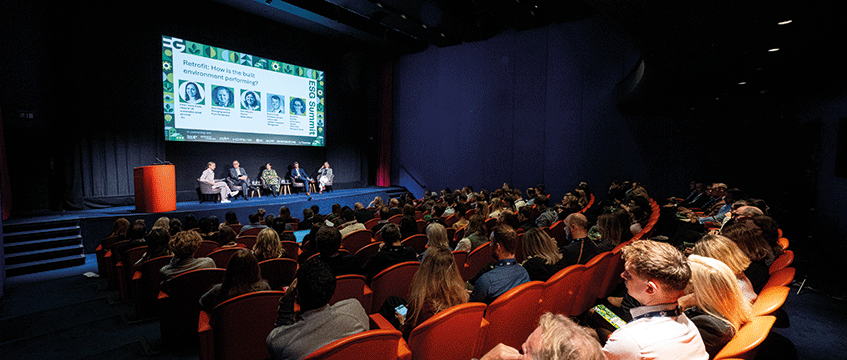Retrofitting real estate: could do better
The case for retrofitting as the most effective means of reducing the built environment’s carbon footprint has been well made, but it’s clear the industry isn’t doing nearly enough of it.
It was a point illustrated by JLL’s head of UK sustainable asset services Katie Krelle in her role as chair of an EG ESG Summit session called Retrofit: How is the built environment performing? The answer to that question, it seems, is badly.
“The UK Green Building Council did a check-in earlier this year on its 2021 Whole Life Carbon Roadmap and it found that operational carbon has reduced by 13% compared with the 17% required,” Krelle said. “Albeit it’s thought that most of our reductions come from the UK’s generation of renewable energy and the decarbonisation of the grid, and only a 4% reduction in embodied carbon compared with the 23% required.”
The case for retrofitting as the most effective means of reducing the built environment’s carbon footprint has been well made, but it’s clear the industry isn’t doing nearly enough of it.
It was a point illustrated by JLL’s head of UK sustainable asset services Katie Krelle in her role as chair of an EG ESG Summit session called Retrofit: How is the built environment performing? The answer to that question, it seems, is badly.
“The UK Green Building Council did a check-in earlier this year on its 2021 Whole Life Carbon Roadmap and it found that operational carbon has reduced by 13% compared with the 17% required,” Krelle said. “Albeit it’s thought that most of our reductions come from the UK’s generation of renewable energy and the decarbonisation of the grid, and only a 4% reduction in embodied carbon compared with the 23% required.”
Fore Partnership managing partner Basil Demeroutis added: “We’re not doing enough. We have all the skills, tools, technology and know-how to decarbonise buildings. There’s nothing we need that we don’t have, so why is it that we are retrofitting only about 1% of the office stock that we need to across the UK?”
Demeroutis continued: “We have this almost unlimited demand from companies. Which company nowadays doesn’t have a net zero carbon target? Something like 80-85% of the FTSE 100 does, and yet can anyone tell me more than five buildings in London that are net zero carbon?”
Practical and tangible
The reason for the lack of progress, Demeroutis said, is partly down to the complexity of the process. Typically, a two-year retrofit project will require the delivery of more than 2m items, meaning developers have to work with hundreds of suppliers to check their decarbonisation credentials.
However, the session was far from a counsel of despair and there was strong belief in both the benefits of retrofit and in its ability to become more ubiquitous.
Bates Wells partner Karli Hiscock highlighted the level of upskilling it will introduce to the labour market and praised it for reducing noise pollution and construction traffic compared with new-build.
Hiscock added: “It’s the engagement around the circular economy principles which I think, as a commercial property lawyer, sometimes were just a little bit lacking in tangibility. People were maybe aware of them but didn’t know how to implement them and I think the retrofit discussion brings that into something practical and tangible.”
Celebrating the imperfect
LaSalle Investment Management European net zero carbon lead Brett Ormrod said: “I think the biggest opportunity for the retrofit movement here, aside obviously from making more energy efficient buildings, is the buildings that we don’t essentially need to construct as a result and a 40% reduction in embodied carbon emissions for reusing existing buildings.”
Ormrod said there would be clear economic benefits brought about through the skills required to retrofit, particularly in the field of heat pumps where there is a dearth of contractors available. “I think the UK could look at other examples across Europe, Norway in particular, where they have two-thirds of the existing housing stock on heat pumps and all new commercial buildings have heat pumps installed,” he said.
From an architectural perspective, Allford Hall Monaghan Morris building performance analyst Ella Smith said: “I think it’s a really exciting time for architectural language and developing an image of celebrating the imperfect within our buildings and being able to tell a story of what has happened to our buildings over time.”
She added: “Historically we have been very good at understanding and modelling the energy efficiency of our buildings and a lot of decisions are made based on that, but now we have an overwhelming amount of knowledge on the embodied carbon related to our buildings and it’s through that modelling that we are starting to see the benefits and make the case for retrofitting rather than new build.”
Hidden benefits
The panel agreed the perceived cost of decarbonisation has deterred many, but Demeroutis illustrated how it can actually be a less costly alternative.
“We did a circular steel exercise at TBC.London, our net zero workspace on the banks of the Thames, where we took 100-year-old steel out of House of Fraser on Oxford Street and repurposed it and put it into our building,” he said. “It’s never been done before.
“We had a bill of £100,000 from the contractor to do it, and at the end of actually going through it and going through the detail of how that was built up we got that down to £10,000 and then actually the contractor ended up paying for it because it came out of their marketing budget as much as anything.”
For retrofit to succeed it will require investors and developers to think very differently and challenge the concept of business as usual. But the rewards are definitely there.
In partnership with
Image © Telling Photography











